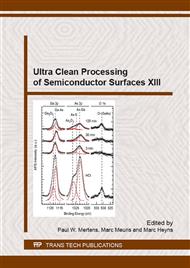p.61
p.69
p.75
p.81
p.86
p.91
p.97
p.105
p.111
Study on the Etching Selectivity of Oxide Films in Dry Cleaning Process with NF3 and H2O
Abstract:
Dry cleaning process has been limited to particular field of removing native oxide because it has low etching selectivity for various oxide films. To increase etching selectivity, we added H2O steam feeding step before NF3 feeding step. From the experimental, we can change selectivity between oxide films from tens to hundreds.
Info:
Periodical:
Pages:
86-90
Citation:
Online since:
September 2016
Authors:
Price:
Сopyright:
© 2016 Trans Tech Publications Ltd. All Rights Reserved
Share:
Citation:


